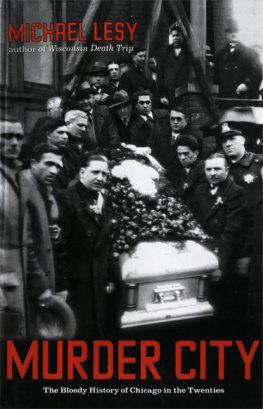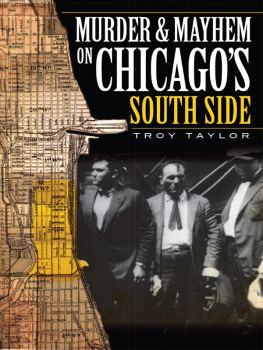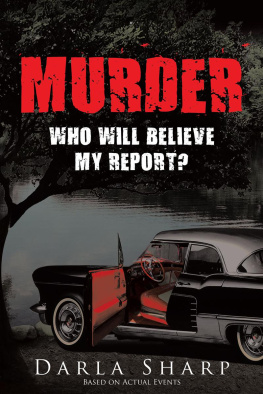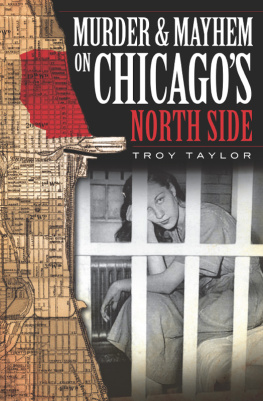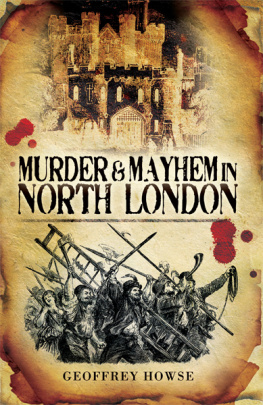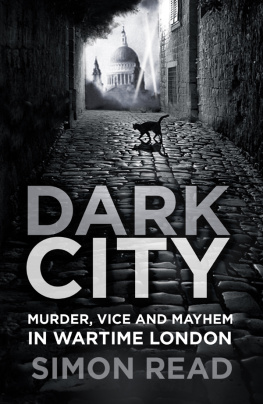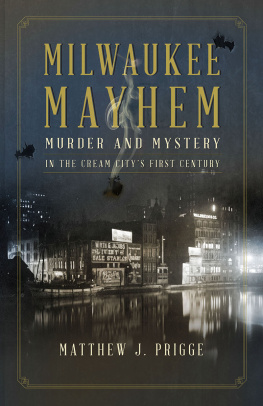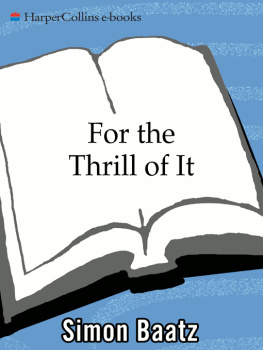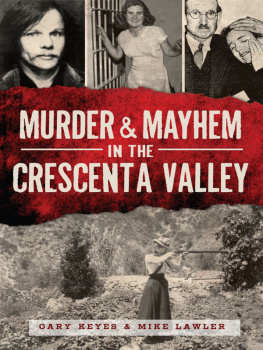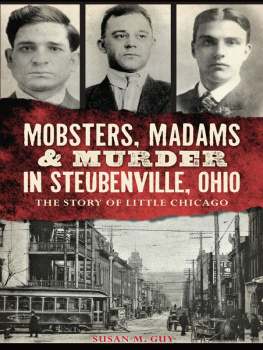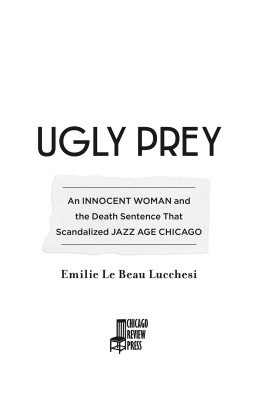
Michael Lesy
MURDER CITY
The Bloody History of Chicago in the Twenties

W.W. Norton & Company
New York London
Carl never lied. He never drank, never smoked, never chewed gum. Everyone knew. Worked in his fathers butcher shop. The ladies liked him. Worked there, then went in the Army. Joined up in 1914. About the time his mother started acting crazy. Used to preach around, Carl said. She had a vision that wouldnt let her rest. Said shed seen Carl lynched, hanging from the limb of a tree. One of Carls sistershis older one, not his twinsaid, It made her despondent. Some people say thats why she killed herself. Slit her own throat. Bumped herself off, Carl said. I was in the Army, then. I liked the Army.
Later, when Dr. Hickson heard that, he said, We can now add latent homosexuality to the complications. Dr. Hickson was head of the citys Psychopathic Laboratory. Psychoanalysis has revealed, he said, that a mania for Army life is one of the inevitably distinguishing characteristics of women haters.... I have observed several such cases while in the Army, myself.
Carl was nineteen when he joined up. The Army made him a machine gunner. Then it made him a sergeant; then it promoted him to second lieutenant. People respected him. His own lieutenant said, I was with him under shell fire in the Alsace sector for months. He was alert, intelligent, very competent, brave, a good soldier. As sane as any man I have ever known.
Carl never gambled. In the Army, I never spent my money.... I saved $800. (That $800 would be worth at least ten times as much today.) Carl came home in October 1919, and married Ruth Johnson a few weeks later. Theyd known each other since they were kids. I never kissed a woman until Ruth came along and never anybody else. Ruth had sung in the choir of Holy Trinity, Lutheran for eight years.resigned from the choir. She said she didnt want to give any other man the opportunity to ask to escort her home after practice.
A month after Carl married her, Ruth announced she was expecting. Carl was back at work at his fathers shop. He and Ruth were living in a room in her parents apartment. They were saving their money so they could buy a home of their own. By June 1920, theyd saved $1,500. (All dollar amounts cited in this chapter are equivalent to ten times their value today. Please see note 10 in the Afterword.) Ruth was eight months pregnant. Shed been buying little things for the baby. Kept a list in her dresser. One day, she told Carl it was time to get their money out of the bank so they could buy a house. Thats what Carl said, anyway.
We never quarreled, he said. A mans duty is to keep his wife happy.... Ive always done what was exactly right and never done wrong.
Once Dr. Hickson heard that, he was ready to make a diagnosis. The citys Municipal Court referred all sorts of cases to Dr. Hickson. His job was to evaluate people before they went to trial. Dementia praecox catatonia, Dr. Hickson said. A very well defined case. A mind geometrically moral but emotionally unmoral. Preoccupied mechanically with ideas of right and wrong...
Of course, if things had worked out differentlyworked out as Carl had plannedDr. Hickson wouldnt have said that.
What happened, according to Carl, was that he and Ruth went to her bank and withdrew all but $70 of her savings. They took the money home with them. Ruth put the cash in her dresser, next to her baby list.
Carl said he stayed home the next day, all day Sunday, to guard the money. Andto guard Ruth.
Thats because, Carl said, Ruth had told him shed noticed a strange man, a raggedy stranger, eyeing her. Suspiciously. Carl was ready for him, though. He had his side arm from the Army. An automatic. A .45.
Monday came and Carl went shopping for a new knife for his father. He worked behind the counter all afternoon. That night, after dinner, he and Ruth decided itd be nice to go to a movie. They went to see Sea Wolf. They left the show early.
As they were walking homeit must have been almost nine-thirty by thenCarl said he noticed a mana raggedy bumfollowing them. The man didnt just follow them. He came up right behind them; he came up right beside them. The city was infested with bums: homeless men, men out of the Army, men out of work. Carl and Ruth kept walking. The man followed them right up the steps into the front hall of their building.
My wife was opening the door, Carl said, but she was having trouble with the key. I spoke to her about it. She said she was going to turn on the light. The man said, Don t do that. He said, No you dont. How about the money.
Carl was ready. He reached for his gun. The man shot Ruth. Carl shot the man. In the dark. In that little hallway. Ten shots. Ruth collapsed. Carl lunged at the man. He knew hed shot him, but Carl grabbed his head and beat it into the floor. Then he swept up his wife. She was bleeding. He carried her upstairs and told her mother to get help.
Ruth was dead. The raggedy stranger was dead. The police lieutenant who interrogated Carl said, I thought he was entitled to a medal for bravery after I listened to his version.
The newspapers thought so, too. WAR HERO IN DEADLY BATTLE. I got him, honey. I got him, the papers wrote Carl had murmured as he cradled Ruths body. There were reports about how Carl had mowed down Germans in the Argonne. How hed been awarded the Distinguished Service Cross. How the French had honored him with the Croix de Guerre. Later, much later, his commanding officer was asked about this. He was not in the Argonne and did not mow down Germans.... He was in officer candidate school behind the lines when the battalion was in the Argonne.
Carl had fought it out with the stranger exactly nine months after hed come home from the Army.
A week passed. Lieutenant Wanderer, Heartbroken Hero. Mourns. Etc. Then the papers found other stories to tell. Carl went back to work behind the counter of his fathers shop.
About the time Carl was mustered out of the Army, the Chicago Police Department established its first Homicide Bureau: its brightest and best detectives, specialists in murder. The department chose a sergeant named John Norton to head the squad. Norton read the papers along with everyone else. If Wanderer was a hero, who was the dead man? There was something else: the dead man had a revolvera heavy-duty Army Colt that fired .45s. Two big guns blazing away in a foyer. Two shots in Ruth. Three shots in the bum. One hole in the floor. Four holes in the walls. Not a scratch on Wanderer. How come?
Everyone knew who Wanderer was, but the bum didnt have a name. Hed been in his twenties, about the same age as Wanderer. He was frail, dirty, dressed in rags. He was going bald. The strange thing was that hed just gotten a haircut. And a manicure. Norton had only two pieces of evidence that could identify the man.
People began visiting the morgue to view the body. The more visitors, the more identities: An elevator operator at a theater identified the man as a fellow shed met in a military hospital in England during the war. Hed been a member of the Canadian Expeditionary Force. Hed told her his father was a wealthy New York turfman who had everything money could buy and heart desire. Nortons squad contacted the police in New York, but they couldnt even find the turfman father.
The head of a Catholic boys orphanage, the Working Boys Home, said he was sure hed seen the dead mans face before. He took some of his boys back to the morgue with him. All the boys recognize him as a former resident of the home, said the priest, but none of them can recall his name.
Next page
